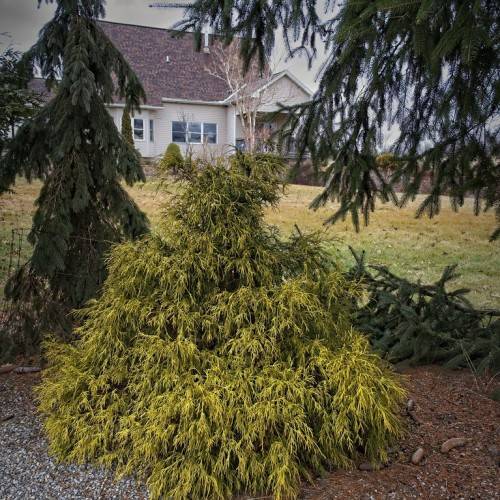
Japanese falsecypress
Chamaecyparis pisifera 'Golden Charm'
Also Known As - Japanese Falsecypress,Sawara Falsecypress,sawara cypressCycle:
Perennial
Watering:
Average
Hardiness Zone:
4
Flowers:
Flowers In Spring
Sun:
Full sun
Fruits:
Fruits Ready In Fall
Leaf:
Yes
Growth Rate:
Moderate
Maintenance:
Low
Drought Tolerant:
Yes
Salt Tolerant:
Yes
Care Level:
Moderate
watering
Japanese falsecypress (Chamaecyparis pisifera 'Golden Charm') should be watered when the top 1-2 inches of soil has gone dry. Water your plant deeply, once a week or whenever the top inch of soil has dried out -- this typically takes a full day or 2 in direct sun. Water until the excess seeps out of the drainage holes. Remember to discard any water accumulating in the drip tray to avoid overwatering.
sunlight
Japanese falsecypress (Chamaecyparis pisifera 'Golden Charm') is an ornamental evergreen shrub best suited for temperate climates and young plants should receive at least 4-6 hours of direct sunlight each day. If the shrub is planted in an area that does not receive full sun, it may not flower and may struggle to stay healthy. The best time for the plant to receive sunlight is during midday, and reducing the amount of afternoon sunlight may be beneficial in areas with very hot temperatures. In hotter regions, it is best to provide the plant with indirect sunlight or partial shade in order to ensure its best health.
pruning
Japanese falsecypress (Chamaecyparis pisifera 'Golden Charm') should be pruned twice a year, once in late spring and once in early summer. The late spring pruning should be light, with just the removal of shoots and/or branches that misshapen the plant or interfere with walkways. The more major pruning should be done in early summer, after the new growth has fully matured. During this time, you can shape the tree, reaching into the depths of the tree and removing dead and diseased branches. You can also selectively remove any branches that are poking up too high or too out of proportion. It is important to never remove more than 1-third of the foliage in any given year.
